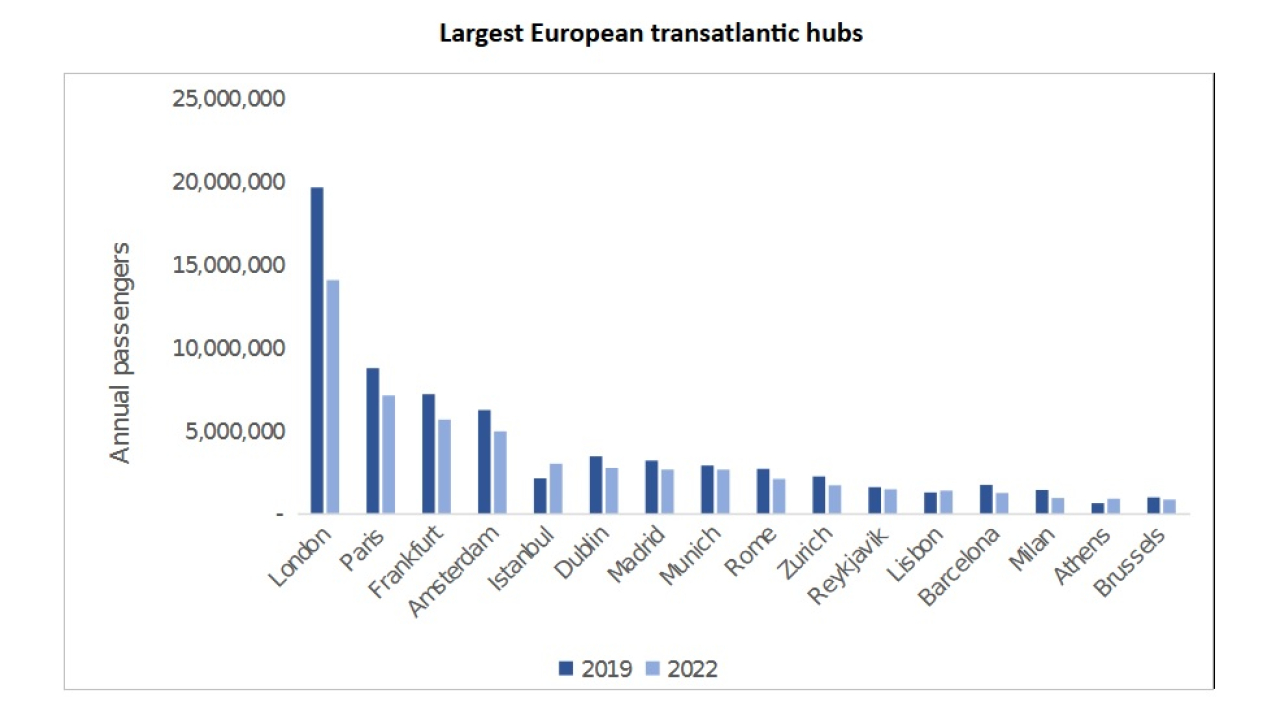USA-Europe Transatlantic Air Traffic: A Second Chance for Low-cost Airlines?
Dion Zumbrink
August 2, 2023

© Rythik / Unsplash
Transatlantic air traffic is catching up in 2023. Scheduled capacity in May was at 98% of 2019 capacity and various airlines such as Delta, Aer Lingus and United plan summer 2023 with their largest capacity ever. This is up from an average recovery in 2022 of 78% of 2019 volumes.
Some factors driving the growth are; airlines switching long-haul capacity from Asia to transatlantic routes; post-pandemic pent-up demand; and a strong US dollar making it more affordable for Americans to visit Europe.
Additionally, a number of airlines – predominantly low-cost carriers – which had been driving the growth pre-pandemic ceased operations and new/replacement airlines are ramping up in 2023. The low-cost market share that built up in the last decade vanished during the pandemic.
The chart below depicts the development of the US-Europe transatlantic market from 2011 by airline type. What can be seen is that the market was traditionally divided between the European (57%) and US (40%) full-service airlines. These airlines have grown with a strong but unremarkable CAGR of around 4.9% between 2011 and 2019.
From 2013-2014 Low-cost airlines were entering and stimulating the market, achieving a CAGR of 25% and lifting the total market CAGR to 5.9%. These airlines obtained a market share of 11% by 2018, led by Norwegian and WOW Air.
The US full-service carriers include the big three – American, United and Delta – making up the three largest airlines in the market. The European side is more fragmented and includes all national flag carriers.
Market-share Slump
The low-cost market almost completely vanished during the pandemic, with its market share in 2021 falling back to just 2%, and in 2022 a little better with 3%. Meanwhile, United has been leading the recovery. In 2022, the carrier was already operating 1% above 2019 levels, while Delta and American stood in the mid-80s range and British Airways and Lufthansa at 75% and 71% of 2019 volumes respectively.

© Dion Zumbrink
United continues its expansion and will likely remain the largest airline in the market in 2023. However, a resurgence of low-cost airlines can be expected with various new initiatives underway and new routes being launched.
New Low-Cost Initiatives Post-Pandemic
New long-haul player Jetblue launches Paris and Amsterdam from New York in 2023, after commencing with London in 2022. Fares are starting at half the price of its full-service competitors. Despite the large price gap, their market share is however not large enough yet to make a difference in overall fares in the market.
Furthermore, Play and Norse are replacing Wow and Norwegian respectively. Leisure-focused French Bee operates routes to New York, Miami, San Francisco, and Los Angeles from Paris Orly, and in 2024 Irish airline Fly Atlantic plans to add to the mix with a fleet of narrow-body aircraft linking Belfast to North America.
Interestingly, the low-cost airlines tend to fly from the key cities already established in the transatlantic market, going head-to-head with the incumbent full-service airlines. The main new European points of departure are London, Paris, Amsterdam, Rome, and Berlin. As can be seen below in the chart setting out the largest European transatlantic hubs, the first three in the list above are already among the largest markets.
Historically it has proven to be difficult to break into the market and sustainably compete with the overwhelming capacity of the incumbents. However, a new generation of low-cost airlines – and some new initiatives – is enabling them to build up their networks. Helping to do this are the latest aircraft generations like the 737MAX and A321XLR which are more fuel efficient and capable of a longer range than previous-generation narrow-body aircraft.
Looking at the market stimulation achieved in the previous decade, the demand for low-cost transatlantic air travel definitely exists and the tools of the airlines to cater for this demand are now better.

© Dion Zumbrink
